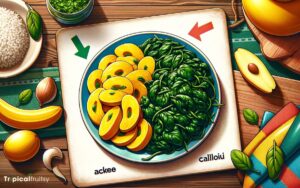How to Cook Ackee and Chicken Back? 8 Easy Steps!
Learn to cook ackee and chicken back, a beloved Jamaican dish, by following a step-by-step guide that highlights the importance of selecting fresh ingredients and mastering cooking techniques.
This dish pairs the subtly sweet flavor of ackee with the savory taste of chicken back, resulting in a rich and comforting meal.
Ackee and chicken back is a flavorful Jamaican dish requiring specific preparation methods for each component:
Ackee and chicken back, a dish steeped in Jamaican tradition, offers a taste of the island’s rich culinary heritage in every bite.
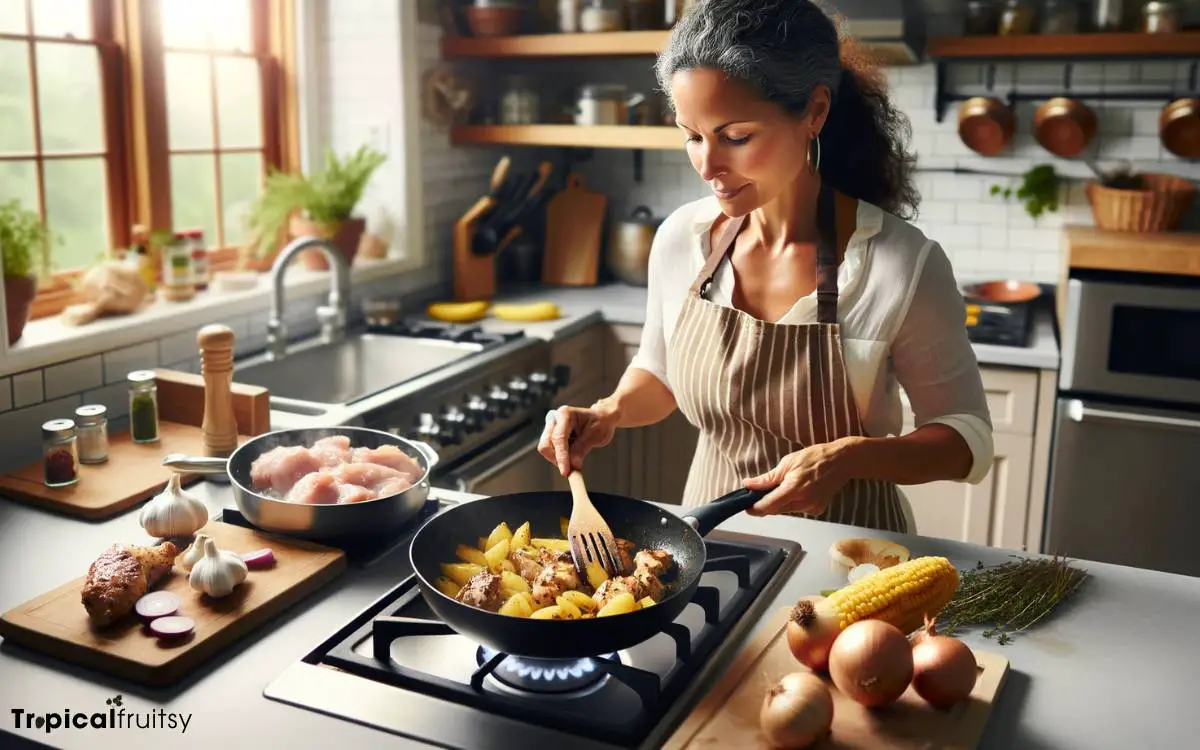
Key Takeaway
Jamaican Chicken Back and Ackee Recipe: Ingredients and Preparation Guide
| Ingredient | Preparation | Cooking Method | Notes |
|---|---|---|---|
| Chicken Back | Clean and season with spices | Simmer until tender | Use traditional Jamaican spices for seasoning |
| Ackee | Carefully clean and remove seeds | Boil until soft | Do not overcook to avoid mushiness |
| Aromatics | Chop onions, garlic, scotch bonnet | Sauté to enhance flavor | Essential for an authentic taste |
| Thyme | Rinse and add whole | Simmer with chicken | Adds a distinctive earthy flavor |
Gather Your Ingredients
Before beginning the cooking process, assemble all necessary ingredients:
- Fresh ackee
- Chicken backs
- Appropriate herbs and spices
Ensure that the ackee is at the pinnacle of ripeness and the chicken backs are well-cleaned and cut into manageable pieces.
You’ll also need aromatic herbs such as thyme and scallions, which will impart the dish with its quintessential flavors.
Scotch bonnet peppers provide a fiery kick, while garlic and ginger offer an earthy undertone. These components are fundamental in achieving the dish’s complex flavor profile.
Additionally, gather cooking oil, salt, black pepper, and any other seasonings you prefer. Precision in preparation sets the stage for a culinary experience redolent of Caribbean tradition and gastronomic satisfaction.
Step 1: Preparing the Chicken Back
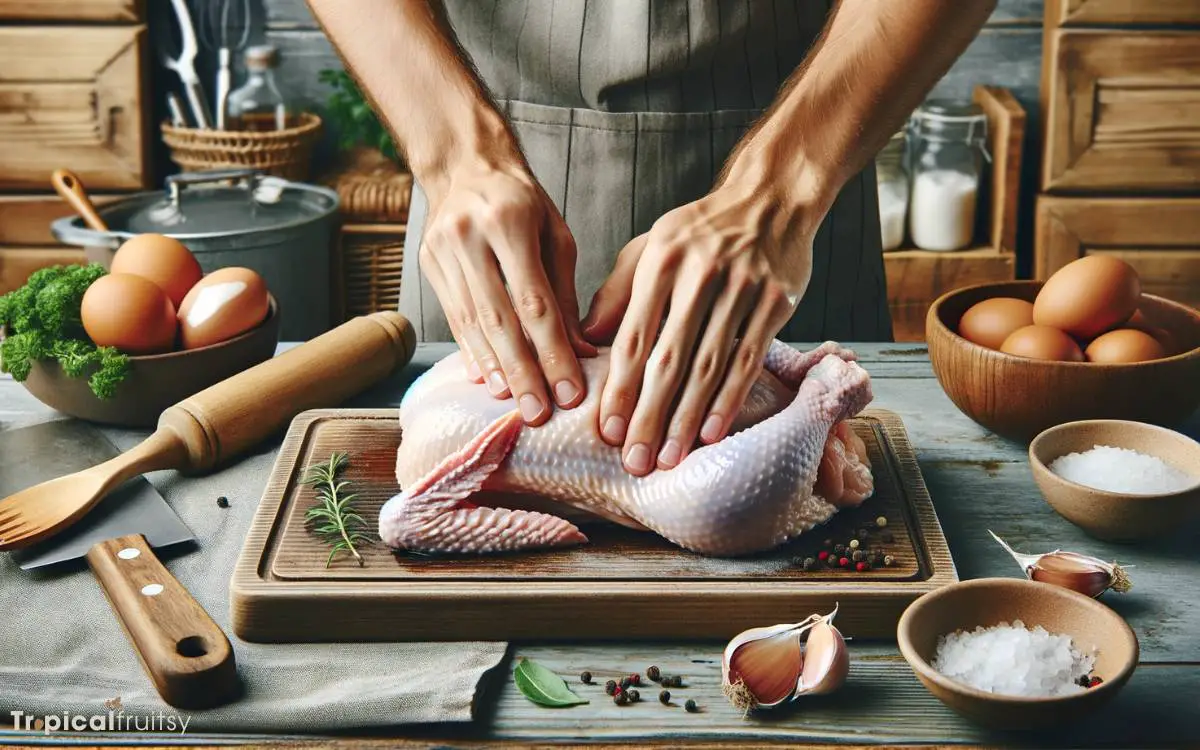
In preparation for the Ackee and Chicken Back dish, commence by thoroughly rinsing the chicken backs under cold water to remove any residual impurities.
This initial cleansing is a pivotal step, ensuring that the chicken is free from debris and ready for further processing. The succulence of your dish hinges on the meticulous preparation of the poultry.
- Trim Excess Fat: Carefully remove any surplus fat to promote a leaner, healthier meal.
- Cut into Suitable Portions: Segment the chicken backs into manageable pieces that will cook evenly and integrate gracefully with the ackee.
- Pat Dry: With a clean towel, pat the chicken dry, which will aid in the adherence of the seasonings.
Having prepared the chicken backs, we now turn our attention to artfully seasoning them, a task that infuses the poultry with the vibrant flavors emblematic of Caribbean cuisine.
Step 2: Seasoning the Chicken
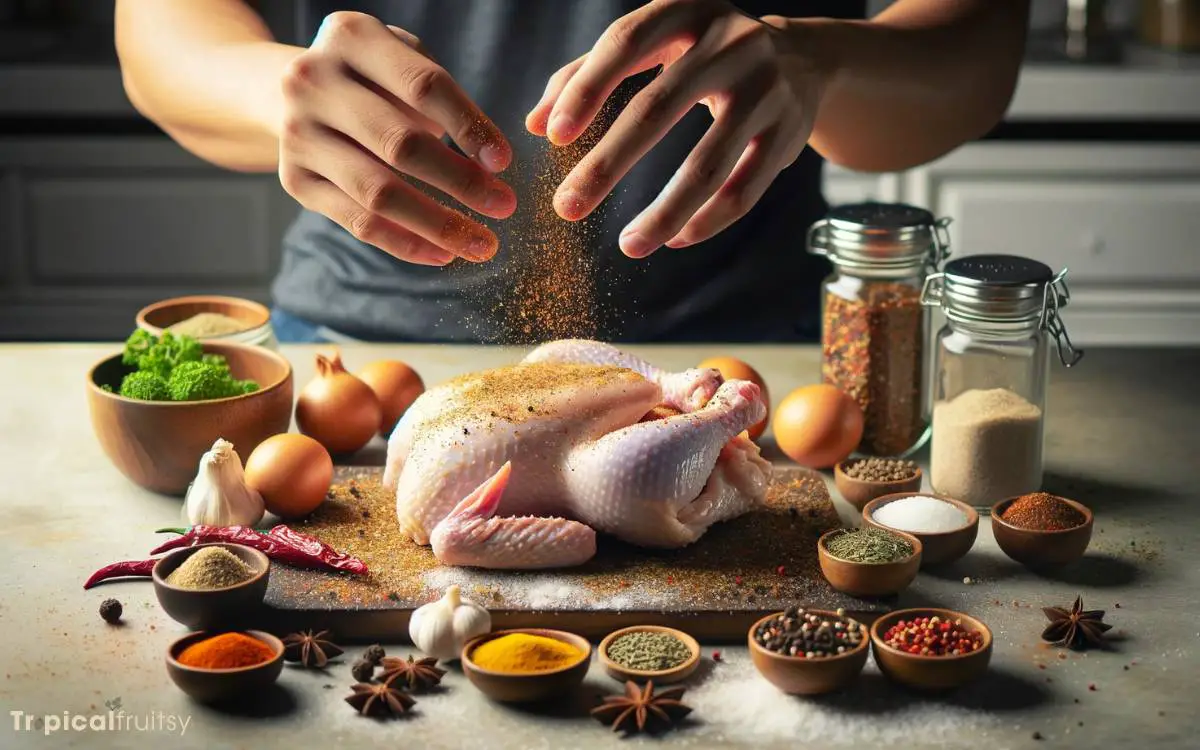
A generous blend of traditional Jamaican spices is essential to imbue the chicken backs with the robust flavor profile characteristic of Ackee and Chicken Back.
To achieve the deep, aromatic notes that the dish is renowned for, one must judiciously employ a medley of spices including thyme, scotch bonnet pepper, scallions, and allspice, also known as pimento.
Garlic and ginger add depth and warmth, while a touch of black pepper brings a subtle heat that awakens the palate.
The chicken should be liberally seasoned, ensuring that each piece is fully coated and allowed to marinate.
This process not only tenderizes the meat but also allows the flavors to penetrate deeply, setting the stage for a truly authentic culinary experience.
Step 3: Cooking Techniques for Chicken
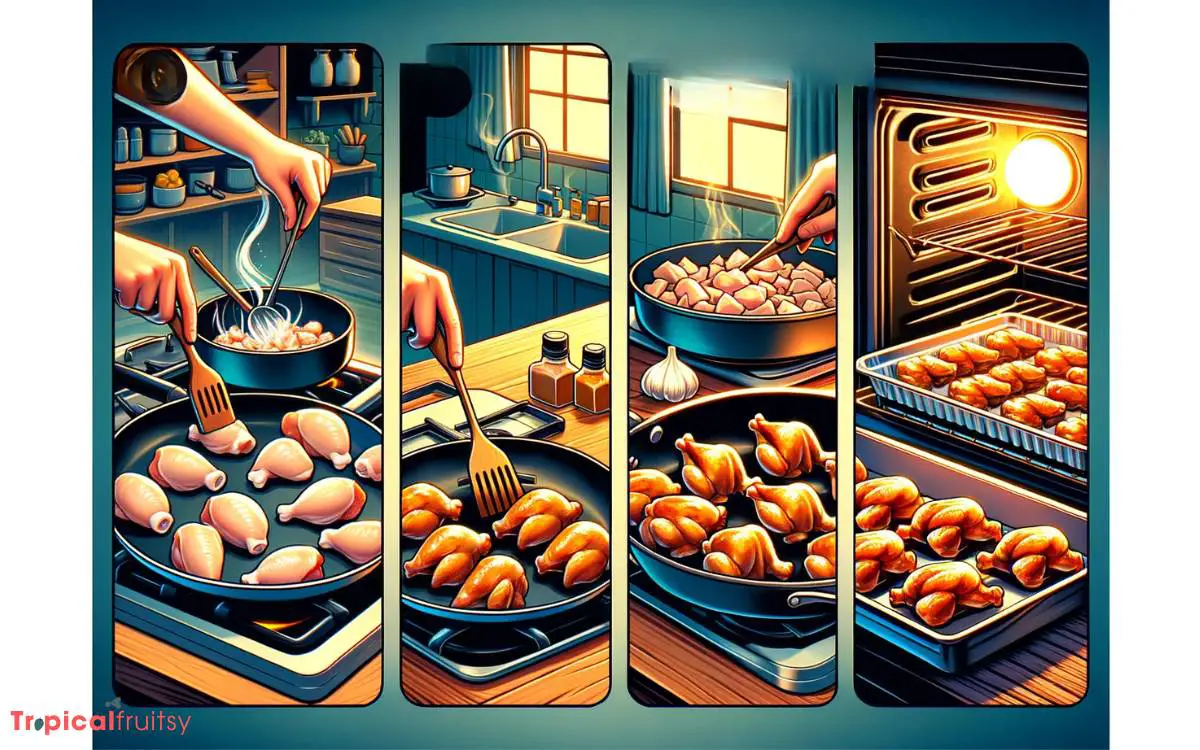
Once the chicken backs are thoroughly seasoned, they should be browned in a heavy-bottomed skillet to lock in flavors before simmering in a rich broth to achieve tenderness.
This process not only imparts a deep, caramelized exterior but also lays the groundwork for a succulent, fall-off-the-bone texture that is highly sought after in traditional dishes.
- Browning: Seal in spices and create a flavorful crust.
- Simmering: Gently cook the chicken to tender perfection.
- Broth: Use a flavorful liquid to enhance the overall taste.
Employing these strategies ensures that the chicken back, often underappreciated, becomes a star in its own right, with robust flavors and a satisfying mouthfeel.
With the chicken prepared appropriately, we can now turn our attention to selecting and prepping ackee, another crucial component of this classic dish.
Step 4: Selecting and Prepping Ackee
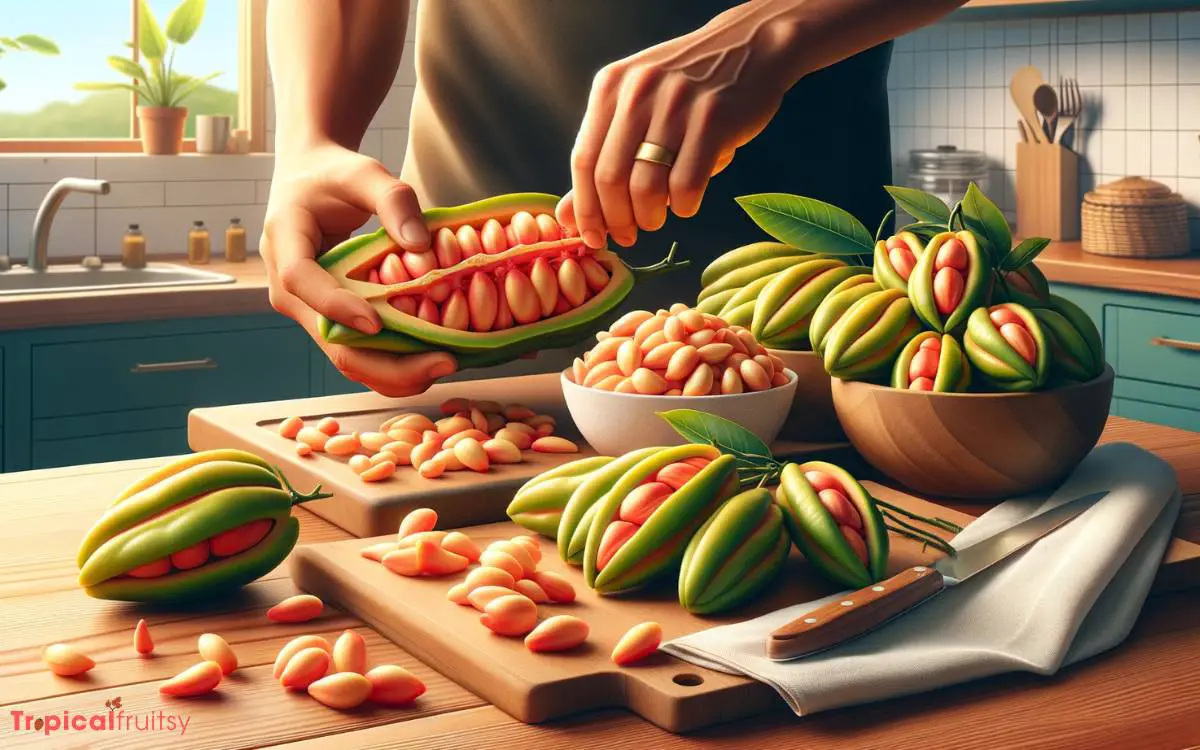
Before incorporating ackee into the dish, it is imperative to select ripe fruit and prepare it carefully to ensure safety and optimal flavor. Ackee, a staple in Jamaican cuisine, is a unique fruit that demands meticulous handling.
When ripe, its protective pods turn from green to a bright red and naturally open to reveal the edible yellow arils inside.
However, one must never force open an ackee pod, as premature ackee contains toxins that can lead to serious health implications.
Below is a table providing guidance on selecting and prepping ackee for your culinary endeavors:
| Criteria | Description |
|---|---|
| Pod Color | Bright red and naturally open |
| Texture | Firm to the touch, not mushy |
| Odor | Mild; absence of fermentation smell |
| Preparation | Remove the black seeds and any red lining |
Understanding these nuances ensures a delicious and safe experience with this exotic fruit.
Step 5: Combining Ingredients

As we transition from the meticulous preparation of ackee, attention must shift towards the harmonization of flavors within our dish.
Marinating chicken back is a pivotal step, infusing it with a robust depth that will complement the delicate nature of the ackee.
Mastering the art of flavor layering is essential to achieving a symphony of taste that elevates this traditional meal to new heights.
Ackee Preparation Safety
Preparing ackee for consumption requires meticulous attention to safety, especially when combining it with chicken back, due to its potentially toxic nature if not handled correctly.
Ackee, when unripe, contains hypoglycin A, a compound that can cause severe illness.
To ensure the safety and palatability of your dish, consider the following guidelines:
- Wait for the ackee pods to open naturally: This signifies that the ackee is ripe and safer to eat. Forcibly opening pods can lead to the risk of toxicity.
- Discard all seeds and inner red membranes: These parts contain the highest levels of hypoglycin A and should never be consumed.
- Boil ackee thoroughly: Before combining it with chicken back, boiling helps to reduce the potential toxins present in the fruit.
Mastering these steps will add depth to the flavors and ensure a safe, delightful culinary experience.
Marinating Chicken Back
Having ensured the safety of the ackee by following the necessary precautions, we now turn to the preparation of the chicken back.
We begin with a flavorful marinade that will infuse the meat with a rich blend of spices and seasonings.
The marinating process is critical, as chicken back, with its deep flavor and robust texture, benefits immensely from ample seasoning.
To create the marinade, start by combining traditional Caribbean herbs like thyme and scotch bonnet pepper with garlic, onion, salt, and a splash of acidity from lime juice or vinegar.
These ingredients are massaged into the chicken, ensuring that every nook and cranny is permeated with flavor.
Allow the chicken to marinate for at least one hour, or for best results, overnight in the refrigerator. This step sets the stage for intricate flavor layering techniques to follow.
Flavor Layering Techniques
Utilizing the marinated chicken back as a foundation, the next step involves meticulously combining it with the boiled ackee and additional aromatics to create a harmonious blend of flavors.
This process is essential in Jamaican culinary tradition, where the layering of flavors is considered an art form.
The technique ensures each ingredient releases its unique characteristics, contributing to the dish’s overall depth and complexity.
- Introduce Aromatics: Sauté onions, garlic, and Scotch bonnet peppers to unlock their fragrant oils, which serve as the aromatic base.
- Combine with Care: Gently fold the ackee into the sautéed mixture, preserving its delicate texture while distributing the flavors evenly.
- Simmer to Perfection: Allow the chicken back and ackee to simmer together, enabling the infusion of the meat’s rich essence into the vegetable components.
Step 6: Simmering for Flavor
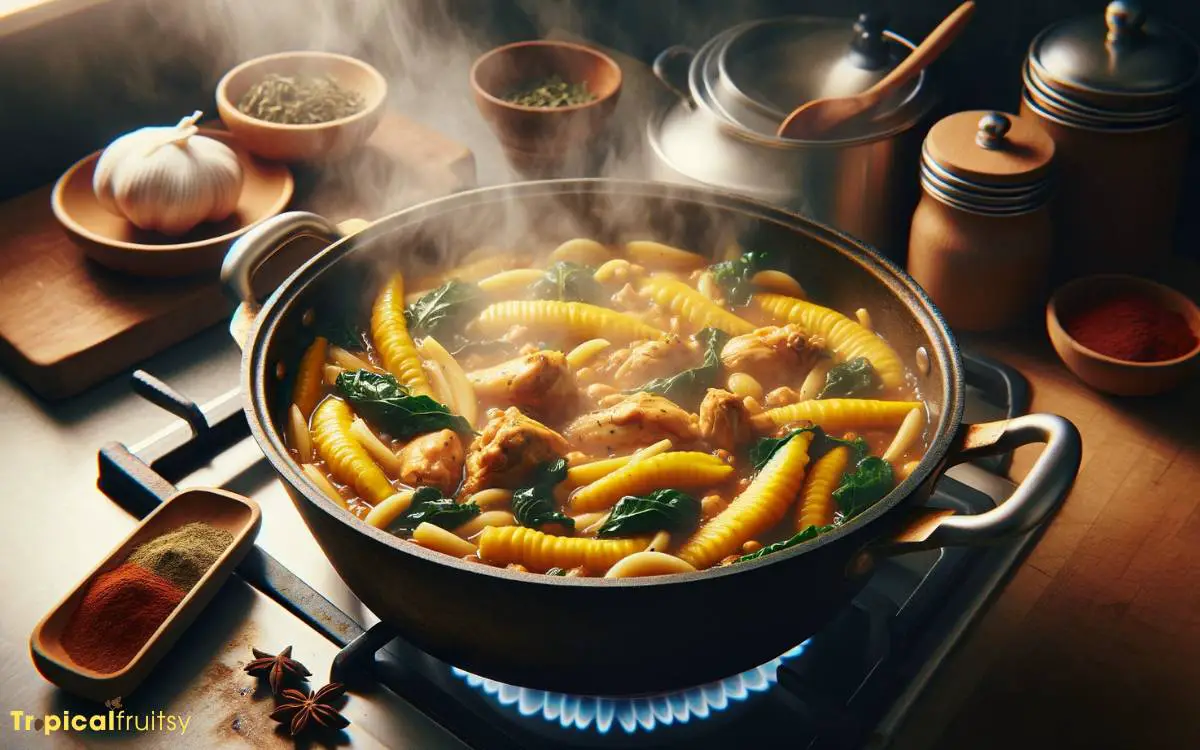
As the ingredients in our ackee and chicken back meld, the gentle art of simmering becomes pivotal. The low heat technique allows flavors to mature gracefully, while guarding the dish’s delicate textures.
The length of time on the stove and the ratio of liquid in the pot are crucial in achieving a harmonious and deeply satisfying taste profile.
Low Heat Technique
Simmer the chicken back gently to infuse the dish with a deep, rich flavor before adding the delicate ackee.
The low heat technique, or simmering, is crucial in Jamaican cuisine, particularly for tenderizing tougher cuts of meat like chicken back while coalescing spices and herbs into a harmonious blend.
This slow cooking process allows flavors to mature and penetrate the meat, ensuring that every bite is succulent and savory.
Key points to remember when employing the low heat technique:
- Maintain a consistent, gentle bubble in the pot; vigorous boiling can toughen the meat.
- Cover the pot to retain moisture and heat, which helps in even cooking.
- Allow time for the chicken to become tender before incorporating the ackee, to preserve its texture.
Time Enhances Taste
One must not underestimate the importance of prolonged simmering, as it significantly amplifies the savory qualities of the chicken back and melds the flavors with the ackee.
This slow cooking process allows the ingredients to commingle, creating a harmony of flavors that is both rich and satisfying. The meat becomes tender, the ackee succulent, and the spices infuse throughout the dish.
Here’s a table to illustrate the simmering stages and their effects:
| Simmering Time | Effect on Chicken Back | Effect on Ackee |
|---|---|---|
| 30 minutes | Begins tenderization | Flavors blend |
| 60 minutes | More tender | Flavors deepen |
| 90+ minutes | Fall-off-the-bone | Full integration |
Respect the simmer, and it will reward you with a dish brimming with complexity and a tapestry of tastes that can only be achieved through the patience of cooking.
Liquid Ratio Importance
The dish’s flavor profile is intricately linked to the liquid-to-ingredient ratio, which must be carefully managed to ensure optimal simmering and taste development.
The simmering process allows flavors to meld harmoniously, and the liquid serves as a medium for the various ingredients to contribute their unique notes to the overall dish.
Here are key factors to consider:
- Sufficient Liquid: Too little and the dish may burn or dry out, compromising texture and taste.
- Intensity of Flavor: A controlled ratio can concentrate or dilute flavors, affecting the final sensory impact.
- Cooking Time: The volume of liquid dictates the cooking duration, influencing tenderness and depth of flavor.
Understanding the pivotal role of liquid ratios sets the stage for presenting the dish with finesse.
Step 7: Serving Suggestions

Accompany your freshly prepared ackee and chicken back with warm, fluffy rice or traditional Jamaican hard dough bread for a satisfying meal.
To enhance the dining experience, consider the following pairings:
| Side Dish | Beverage |
|---|---|
| Steamed white rice | Chilled ginger beer |
| Fried dumplings | Coconut water |
| Boiled green banana | Fresh cane juice |
| Fried plantains | Hot mint tea |
| Bammy (cassava flatbread) | Sorrel drink |
Each side dish complements the rich flavors of the ackee and chicken back, while the suggested beverages offer a refreshing balance.
The vibrant mix of textures and tastes is a testament to the culinary tapestry of Jamaica. As you relish the hearty flavors, let’s consider how to preserve this delight for another day.
Can I Use Frozen Ackee in the Ackee and Chicken Back Recipe?
When it comes to the Ackee and Chicken Back recipe, many wonder if they can use frozen ackee instead. Absolutely! Cooking frozen ackee in 5 steps is simple. First, defrost the ackee thoroughly. Second, heat oil in a pan and add diced onions and garlic. Third, mix in the ackee gently. Fourth, season with salt, pepper, and your choice of spices. Finally, let it simmer for a few minutes until fully cooked. Enjoy a delicious twist on the classic recipe with frozen ackee!
Step 8: Storing Leftovers
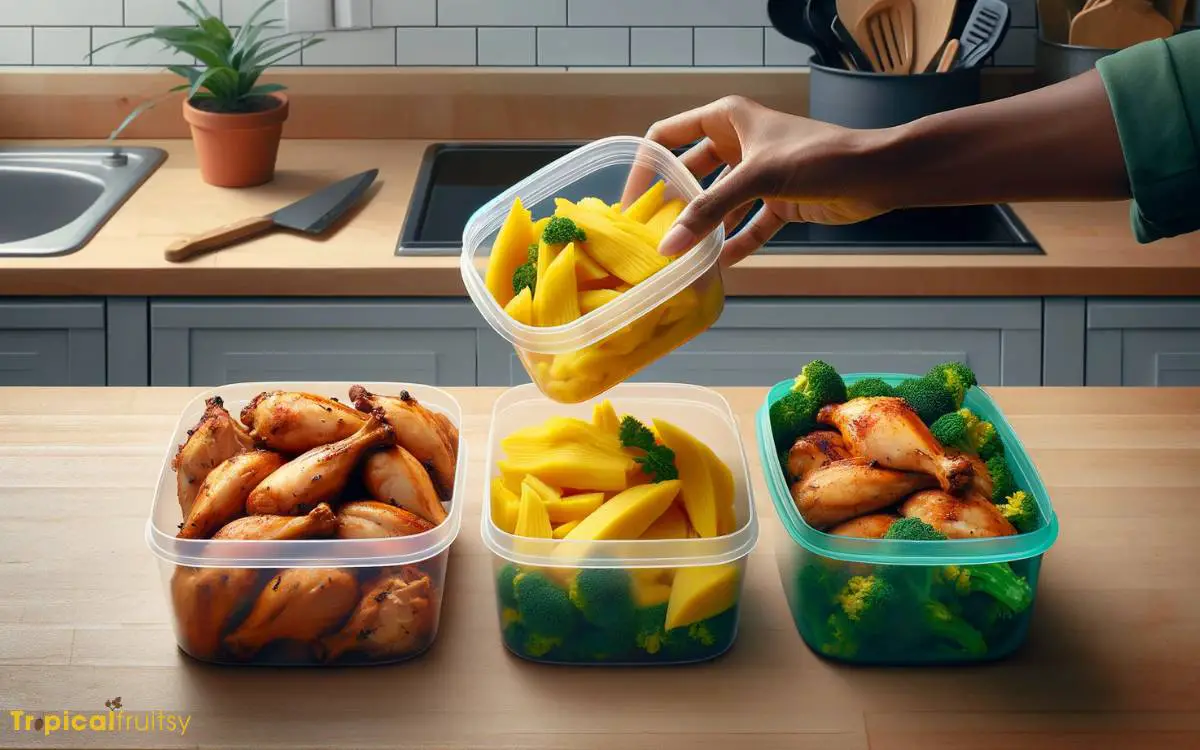
Maximize the longevity of your ackee and chicken back feast by employing proper storage techniques post-meal.
The succulent flavors of this traditional dish can be preserved with attention to detail, ensuring that every subsequent serving is as enjoyable as the first.
To maintain the dish’s integrity, consider the following storage tips:
- Cool Quickly: Allow leftovers to reach room temperature before refrigerating to prevent bacterial growth.
- Airtight Containers: Utilize airtight containers to ward off contaminants and retain moisture.
- Prompt Consumption: Plan to consume refrigerated leftovers within 3-4 days to enjoy the flavors at their peak.
Conclusion
In the culinary tapestry of Caribbean cuisine, the fusion of ackee and chicken back represents a harmonious blend of earth and tree, where the humble chicken—symbolic of nourishment and sustenance—meets the buoyant ackee, emblematic of Jamaican heritage.
This dish not only satiates hunger but also serves as a cultural synapse, connecting generations through the rich flavors simmered within its depths.
Preserving and sharing this recipe honors a legacy of resourcefulness and culinary ingenuity.






